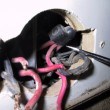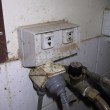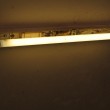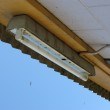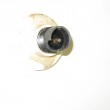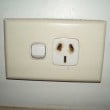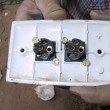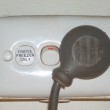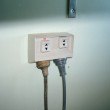A1.4 Power points, lights and other fittings
Faulty or broken electrical fittings can cause an electrical shock or a fire. Fittings are more likely to fail if they are not robust enough for harsh environmental conditions or to meet the demands of a large household. A broken light bulb or light fitting could also indirectly cause a house fire because people may use candles or another type of flame for light.
As water and electricity are a dangerous combination, there is an increased risk of electrical shocks in wet areas (laundry, bathroom and kitchen) and external areas of the house. In places like these, make sure that weatherproof fittings are used and keep water away from electrical points, fittings and appliances. Australian wiring rules have diagrams to assist correct placement.
Standard power points, lights, fans and other electrical fittings are likely to fail more quickly under extreme environmental conditions, such as the constant dust of dry and hot environments, or high humidity in the tropics. Household pests can cause faults in electrical fittings by nesting in them (see A1.3 ‘Cabling and wiring’). Electrical fittings may also have a shorter life in a large or busy household because they are used more often. Electrical fittings may be damaged by exposure to water or chlorine based cleaning products during house cleaning.
A poor quality power supply, resulting in extreme power variations, is another cause of failure in electrical fittings. Specify fittings to suit the power generation system. For example, incandescent globes are particularly susceptible to surges in the power supply but other types of lamps such as fluorescent tubes, are more able to tolerate these conditions.
Avoid single, centrally located bayonet light fittings when they do not provide adequate light for the room. To boost light levels some people use light globes with a higher wattage than that recommended for the fitting. This can lead to increased heat and subsequent fitting failure and damage to wires within the fitting.
If there are not enough power points in a room or if they are in the wrong location, people may use double adaptors, power boards and extension cords, which they could trip over and cause electrical faults. Also make sure that there are outside power points for external living areas and verandahs.
Power points and light switches also need to be in safe and accessible locations, away from water and heat sources, high enough that young children will not play with and accessible to people with disabilities. The recommended height of switches and power points for use by people with disabilities is in line with door handles (900mm to 1100mm above floor level. A ‘rocker’ action, toggle, or push-pad switch with a width of 35mm is recommended).
Design and Specification
Ensure
- A1.4.1.
power points, switches and other electrical fittings are located away from taps, spouts, shower roses, heaters, stoves and gas bottles
- A1.4.2.
foil backed insulation is not installed over light fittings
- A1.4.3.
there are several power points in each room, located in different parts of the room to suit different furniture layouts
- A1.4.4.
aluminium bayonet light fittings are not used
- A1.4.5.
all light switches and power points are fitted between 900 and 1100 above floor level
- A1.4.6.
switches that have mechanical fixings to prevent the switch mechanism being pushed into the fitting
- A1.4.7.
fan control switches are designed with non-push, robust switch mechanism and hard to remove control knobs
- A1.4.8.
there is sufficient light for people with visual impairment, or sufficient capacity in the wiring so that the light fittings can be changed or supplemented without rewiring.
- A1.4.9.
light fittings are located to allow globes and tubes to be easily replaced
Consider
- replacing all single power points with double power points when renovating houses
- locating light switches and power points away from corners and doors so that they can be reached by people with disabilities
- installing light fittings at a height that can be reached by residents without the need of a high ladder– for example 2400mm above floor level
- using large switches (minimum 35mm width) that are easier to operate
- for energy saving, within larger rooms of the house, have lights separately switched
- installing dust and weather protected power points, light switches and fittings in wet areas and external areas, and maybe throughout the house (with a minimum International Protection (IP) rating of 53)
- increasing durability by using light switches and power points with a ‘grub’ screw, or a fitting where the switch mechanism has a backing plate, or sliding switches
- not using mounting blocks for switches
- not fixing light switches or other fittings to architraves
- specifying lights, power points, switches and other electrical fittings that are sealed to prevent damage by rodents and insects
- providing dust and weather protected light switches, power points and television antenna points to external living areas
- installing a power point in the meter box to enable use of power tools without running electrical lines through windows.
Real world examples of Solutions
- A1.4.1.
Quality control
- the number and position of power points, including height above the floor, in all rooms

- SKETCH DESIGN
COMPLETED DESIGN & SPECIFICATION
DURING CONSTRUCTION
AT HANDOVER
FINAL COMPLETION
- SKETCH DESIGN
- that weather protected power points and light switches have been fitted where specified and are installed in wet areas

- COMPLETED DESIGN & SPECIFICATION
AT HANDOVER
FINAL COMPLETION
- COMPLETED DESIGN & SPECIFICATION
- that all power points are located safe distances from plumbing fittings

- COMPLETED DESIGN & SPECIFICATION
DURING CONSTRUCTION
AT HANDOVER
FINAL COMPLETION
TRADE TEST
- COMPLETED DESIGN & SPECIFICATION
- that power points, switches and other fittings are sealed and secured to the wall

- AT HANDOVER
FINAL COMPLETION
TRADE TEST
- AT HANDOVER
- that light fittings and fans are secured to the ceiling

- AT HANDOVER
FINAL COMPLETION
TRADE TEST
- AT HANDOVER
- if fittings are not set out to the adaptable housing requirements, confirm that cabling allows for future works to upgrade the installation to meet this standard

- COMPLETED DESIGN & SPECIFICATION
DURING CONSTRUCTION
AT HANDOVER
- COMPLETED DESIGN & SPECIFICATION
- all power points are correctly wired and tested.

- AT HANDOVER
FINAL COMPLETION
TRADE TEST
- AT HANDOVER
- that all light switches, fittings and bulbs / tubes / lamps are working.

- AT HANDOVER
FINAL COMPLETION
TRADE TEST
- AT HANDOVER
- the number and position of power points, including height above the floor, in all rooms
Maintenance
As part of cyclical maintenance, check that:
- power points, switches and other fittings are sealed and secured to the wall, particularly corrugated walls

- Electrician, Local Maintenance Team, Housing Management
- 12 Months
- all switches are working properly, are not cracked and have not been pushed into the fitting

- Local Maintenance Team, Housing Management
- 12 Months
- power points and light switches for fine cracks, because these can increase the risk of electrical shock

- Local Maintenance Team, Housing Management
- 12 Months
- after upgrading or renovation, power points and light switches have not been painted over.

- Local Maintenance Team
- 12 Months
- arrange for an electrician to replace power points, switches, lights and other fittings that are broken, are cracked, unsealed, or have been painted over.

- Electrician, Housing Management
- 12 Months
- if replacing standard power points, consider weather protected power points in wet areas and external areas.

- Electrician, Housing Management
- 12 Months
- if cleaning the house with water and/or chlorine based products, protect electrical fittings from getting wet. Chlorine based products contain ‘salts’ that continue to attract water to areas where the products have been applied and therefore are particularly hazardous near electrical switches and power points.

- Local Maintenance Team
- 12 Months
- if replacing incandescent globes, consider compact fluorescent lamps, or replacing the whole light fitting with a fluorescent or LED fitting. Before doing this, make sure the new lamps are available at a nearby store.

- Electrician, Local Maintenance Team, Housing Management
- 12 Months
- power points, switches and other fittings are sealed and secured to the wall, particularly corrugated walls
Standard And References
AS 1428.1:2021 - Design for access and mobility
AS/NZS 3000:2018 - Electrical installations (known as the Australian/New Zealand Wiring Rules)

